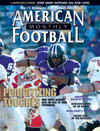AMERICAN FOOTBALL MONTHLY THE #1 RESOURCE FOR FOOTBALL COACHES
Article CategoriesAFM Magazine
|
The Strength Report: Developing the Explosive Athlete - Defensive Backsby: Jimmy RadcliffeHead Strength & Conditioning Coach, University of Oregon © More from this issue The philosophy on training high level football athletes is a basic one with simple principles. Each individual athlete, for the two to five years of their athletic career, will establish specific goals and objectives for themselves. As a commitment to ‘training’ as a high level or elite competitor, what can reliably be improved upon to develop a better skilled player or defensive back? Within the terms of training, for the game of football long term, is the length of the athlete’s career. Being more powerful in the ability to get out of a stance, accelerate to a certain point, be forceful in engagement with an opponent, and agile enough to power through, around and from that engagement quickly and efficiently are all important to make whatever play is necessary. Individuals do not necessarily use their incredible weight room ....The full article can only be seen by subscribers. Subscribe today!
|
|
|||||||
| HOME |
MAGAZINE |
SUBSCRIBE | ONLINE COLUMNISTS | COACHING VIDEOS |
Copyright 2025, AmericanFootballMonthly.com
All Rights Reserved





